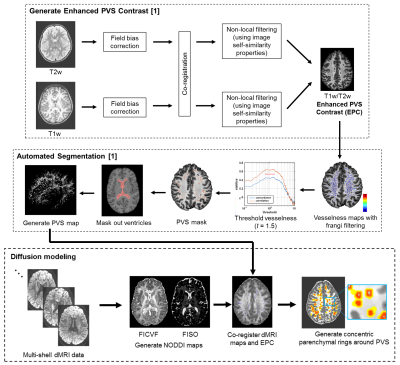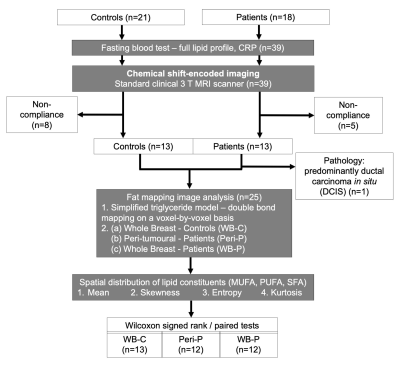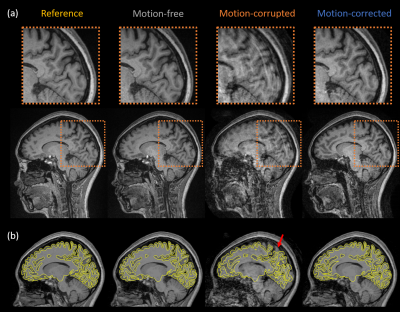Digital Poster
Normal Development & Aging: Poster Session I
Joint Annual Meeting ISMRM-ESMRMB & ISMRT 31st Annual Meeting • 07-12 May 2022 • London, UK

| Computer # | ||||
|---|---|---|---|---|
1943 |
38 | Scyllo-inositol: concentration changes associated with aging and alcohol use, and T2 measurement.
Dinesh K Deelchand1, J. Riley McCarten2,3, Laura Hemmy2,4, Edward Auerbach1, Lynn Eberly5, and Małgorzata Marjańska1
1Radiology, University of Minnesota, Minneapolis, MN, United States, 2Geriatric Research, Veterans Affairs Health Care System, Minneapolis, MN, United States, 3Department of Neurology, University of Minnesota, Minneapolis, MN, United States, 4University of Minnesota, Minneapolis, MN, United States, 5Division of Biostatistics, University of Minnesota, Minneapolis, MN, United States
The goals of this study were to investigate the effect of alcohol usage on scyllo-inositol (sIns) in young and older healthy adults, and measure the T2 of sIns in young and older healthy adults. Two brain regions (occipital cortex (OCC), posterior cingulate cortex (PCC)) were studied at 3T. sIns was measured using a short-echo-time STEAM while T2 was measured using LASER. sIns in OCC and PCC regions was found to increase as the brain ages; alcohol usage (0-2 drinks/week) was significantly different between age groups. In addition, there seems to be a trend towards lower T2 of sIns with age.
|
||
1944 |
39 | Sex-specific differences in the relationships between obesity, cerebral perfusion and grey matter volume Video Not Available
Brittany Intzandt1,2,3,4, Safa Sanami2,4,5, Julia Huck4,5, Rick D Hoge6, PREVENT-AD Research Group7, Louis Bherer 2,3,8, and Claudine J Gauthier2,4,5
1School of Graduate Studies, Concordia University, Montreal, QC, Canada, 2Centre EPIC, Montreal Heart Institute, Montreal, QC, Canada, 3Centre de Recherche de l’Institut Universitaire de Geriatrie de Montreal, Montreal, QC, Canada, 4PERFORM Centre, Concordia University, Montreal, QC, Canada, 5Department of Physics, Concordia University, Montreal, QC, Canada, 6Department of Neurology and Neurosurgery, McGill University, Montreal, QC, Canada, 7StoP-AD Centre, Douglas Mental Health Institute Research Centre, Montreal, QC, Canada, 8Department of Medicine, University of Montreal, Montreal, QC, Canada
Cerebral health declines in aging. Obesity is reported to accentuate, reduce or have no effect on these declines. Given sex differences are present for cerebral health and obesity individually, it is hypothesized these discrepancies are influenced by sex. Here, we investigated the relationship between obesity, cerebral structure and perfusion in aging females and males separately. Females revealed greater obesity was associated with increased structure and perfusion. Males demonstrated a positive relationship with obesity and perfusion, however, an inverse association was identified between structure and obesity. Future work should investigate the influence of other lifestyle factors on these sex-specific relationships
|
||
1945 |
40 | Age-related changes to perivascular and parenchymal fluid flow dynamics with multi-compartment diffusion MRI
Kirsten Mary Lynch1, Rachel Custer1, Ryan P Cabeen1, Francesca Sibilia1, Arthur W Toga1, and Jeiran Choupan1
1USC Mark and Mary Stevens Institute for Neuroimaging and Informatics, University of Southern California, Los Angeles, CA, United States
Perivascular spaces (PVS) play a critical role in fluid transfer and waste clearance in the brain. PVS enlargement is associated with advancing age; however, the functional correlates of these changes are not well understood. Using multi-compartment diffusion models, we assessed the diffusion properties within the PVS and the surrounding parenchyma in a healthy aging cohort. We found age was significantly associated with increased perivascular free water content and reduced parenchymal free water content. These findings provide preliminary evidence of age-related changes to perivascular fluid transfer that may be indicative of waste clearance functional alterations.
|
||
1946 |
41 | The primate corpus callosum - Age-related differences in morphology and microstructure
Rakshit Dadarwal1,2, Judith Mylius1, Amir Moussavi1, and Susann Boretius1,2
1Functional Imaging Laboratory, German Primate Center, Göttingen, Germany, 2Georg-August-University Göttingen, Göttingen, Germany
Aging of the brain has been associated with several structural and functional changes, including tissue volume loss, white matter integrity loss, and changes in iron concentration. However, the fundamental mechanism driving these changes and their significance in the development of age-related neurodegenerative diseases are still not very well understood. Due to their unequivocal similarity with humans, non-human primates may be of particular value to further explore these mechanisms. In this study, we looked at age-related morphological, tissue microstructural, and iron-concentration changes in the corpus callosum of macaques and marmosets.
|
||
1947 |
42 | Peri-tumoural distribution of lipid composition in postmenopausal patients with oestrogen receptor positive breast cancer
Sai Man Cheung1, Kwok-Shing Chan1,2, Wenshu Zhou1, Ehab Husain3, Tanja Gagliardi1,4, Yazan Masannat5, and Jiabao He1
1Institute of Medical Sciences, University of Aberdeen, Aberdeen, United Kingdom, 2Donders Institute for Brain, Cognition and Behaviour, Radboud University, Nijmegen, Netherlands, 3Pathology Department, Aberdeen Royal Infirmary, Aberdeen, United Kingdom, 4Radiology Department, Royal Marsden Hospital, London, United Kingdom, 5Breast Unit, Aberdeen Royal Infirmary, Aberdeen, United Kingdom
Early diagnosis is crucial for the prognosis of patients with breast cancer. Postmenopausal women with oestrogen receptor positive cancer account for over half of all new diagnosis, with an imbalance of lipid composition in peri-tumoural adipose tissue. Since oestrogen is primarily modulated by mammary adipocytes, lipid composition monitoring for early sign of heterogeneous lipid deregulation is central to the accurate early detection. Novel chemical shift-encoded imaging (CSEI) allows rapid lipid mapping of whole breast. We set out to elucidate the spatial distribution in the deregulation of peri-tumoural lipid composition in postmenopausal patients with oestrogen receptor positive breast cancer using CSEI.
|
||
1948 |
43 | Microstructural and functional connectivity changes in the locus coeruleus: a 7T study in cognitively impaired subjects
Ileana Jelescu1, Federica Ribaldi2, Konstantin Toussas3, Sandra da Costa4, Joao Jorge4, Olivier Reynaud 4, Giovanni B Frisoni3, Jorge Jovicich5, and Michela Pievani6
1CHUV, Lausanne, Switzerland, 2UNIGE, Geneve, Switzerland, 3UNIGE, Geneva, Switzerland, 4EPFL, Lausanne, Switzerland, 5CIMEC, Trento, Italy, 6IRCCS Brescia, Brescia, Italy
The locus coeruleus (LC) is a brainstem nucleus thought to undergo early microstructural and functional connectivity changes in Alzheimer’s disease. The in vivo assessment of LC changes is however limited by the resolution of current 3T MRI systems. Here we used high-resolution high-field diffusion weighted imaging (DWI) and resting-state fMRI in cognitively impaired older persons to investigate diffusion and functional connectivity LC changes, and their association with cognition and connectivity of large-scale networks. Results show reduced diffusivity in the caudal LC and associations between microstructural changes, memory deficits, and lower functional connectivity of the dorsal and ventral attention networks.
|
||
1949 |
44 | Evaluation of Scout Accelerated Motion Estimation and Reduction (SAMER) for measurement of brain volume and cortical thickness
Wei-Ching Lo1, John Conklin2,3, Bryan Clifford1, Qiyuan Tian2,3, Daniel Polak2,4, Daniel Nicolas Splitthoff4, Maria Gabriela Figueiro Longo2,3, Azadeh Tabari2,3, Stephen Cauley2,3, and Susie Yi Huang2,3,5
1Siemens Medical Solutions, Boston, MA, United States, 2Department of Radiology, A. A. Martinos Center for Biomedical Imaging, Massachusetts General Hospital, Charlestown, MA, United States, 3Harvard Medical School, Boston, MA, United States, 4Siemens Healthcare GmbH, Erlangen, Germany, 5Harvard-MIT Health Sciences and Technology, Massachusetts Institute of Technology, Cambridge, MA, United States
Scout Accelerated Motion Estimation and Reduction (SAMER) is a novel technique that can mitigate motion artifacts in MR images. In this study, we compared the brain volume and cortical thickness measurements obtained from in vivo motion-free, motion corrupted, and motion corrected images acquired with SAMER to those from a motion-free standard MPRAGE reference scan. The quantitative analysis of motion-free and motion corrected SAMER images showed comparable results with motion-free standard MPRAGE.
|
||
The International Society for Magnetic Resonance in Medicine is accredited by the Accreditation Council for Continuing Medical Education to provide continuing medical education for physicians.